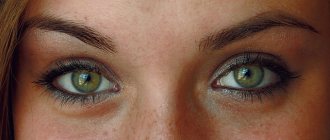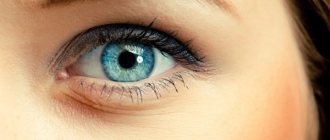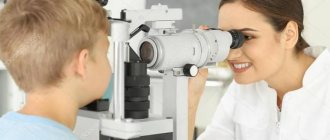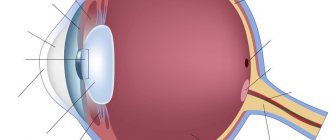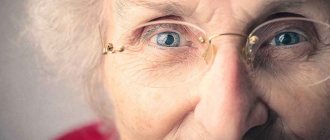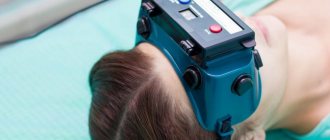Many modern people are concerned with the following questions: how exactly do digital gadgets affect our vision? What are the most obvious symptoms of computer vision syndrome? How to properly organize a workplace in front of the monitor? The answers to them were prepared by Ochkov.Net specialists.
Electronic gadgets have become quite firmly entrenched in our lives. Today it is difficult to surprise anyone with the presence of a laptop, tablet, smartphone or e-reader. According to official statistics, many modern people spend at least eight hours a day on their digital technical devices. In parallel with this, scientists also cite sadder statistics, according to which about 15 million people in our country suffer from various vision diseases, the main cause of which is actively developing technological progress. According to ophthalmologists, the constant use of various digital devices can lead to the rapid development of myopia, as well as the occurrence of “dry eye” syndrome, which, as a rule, manifests itself due to slow blinking and insufficient hydration of the cornea. In addition, many modern optometrists agree that the level of backlight brightness used in laptops or smartphones poses a particular danger to eye health. According to experts, it should be adjusted so that it does not exceed 1/3 when the user is in the room. Otherwise, such radiation can be very dangerous for the visual organs. We are confident that the material we have prepared about digital devices will be very useful for all people who spend a lot of time on computer equipment and also do not part with mobile devices.
What is computer vision syndrome?
First, let's look at what the phenomenon of computer vision syndrome is, because in the era of digital technology, any modern person should have an idea of this phenomenon. The most characteristic signs of this disease, ophthalmologists include the following symptoms:
- fatigue;
- redness of the cornea
- the appearance of a veil before the eyes;
- increased photosensitivity;
- increased blinking of the eyelids;
- duality of image;
- feeling of “sand” in the eyes;
- feeling of heaviness in the eyelid area.
Quite often, the symptoms we have listed above are accompanied by such unpleasant sensations as pain in the eye area, blurred vision, rapid fatigue during prolonged work, for example, at the computer, as well as slower focusing on a particular object.
According to experts in the field of ophthalmology, the reason for this is not the radiation of gadgets, but the incorrect organization of work with digital technical devices. Scientists explain this as follows. It's no secret that the image we see on the screen is significantly different from the one that could be captured on a piece of paper. From the point of view of physics, it is not reflected, but self-luminous, consisting of many discrete points - pixels. It is generally accepted that the less regular the flickering, the lower the accuracy of the accommodation setting.
In addition, according to experts, the fatigue of our visual organs when working with digital technical devices is significantly influenced by the need to continuously move our gaze from the screen to the keyboard. Certain errors in the organization of the workplace cannot be ruled out, as a result of which an incorrect distance from the eyes to the monitor is formed, and various glare reflections projected by external light sources and even incorrect color rendition installed on the computer or any of the digital devices you use may also occur. Among other things, according to ophthalmologists, prolonged work at the monitor often contributes to disruption of tear exchange, which also leads to decreased vision and general fatigue.
Take care of your eyesight from a young age
Natalya Ivakina, Russia, St. Petersburg
The life of a modern person, especially a young person, is unthinkable without a computer, smartphone, tablet and other gadgets. Without a doubt, they have influenced and changed our daily lives. This also manifested itself in the fact that the strain on the eyes has increased many times over. Starting early in the morning, we peer, read, peer, so that our eyes have a very difficult time. We will tell you how to effectively protect your eyesight in this article.
Academician Sergei Ivanovich Vavilov in his book “The Eye and the Sun” wrote:
A living creature has no more faithful and powerful protector than the eye. To see means to distinguish between enemy and friend and the surroundings in every detail. Other sense organs do the same thing, but incomparably coarser and weaker. Touch and the feeling of warmth give us information about the outside world only through direct contact; hearing and smell, informing from afar, do not sufficiently inform about distance, direction and shapes. Our words “obviously”, “wait and see” are equivalent to the fact that appearance is certainty. <…>
In this sense, we must understand the saying of Anaxagoras: “vision is the appearance of the invisible” - the invisible world becomes a reality, a phenomenon through vision. Thanks to vision, we receive 90% of information about the environment around us. Acute vision has been valued at all times. Now we do not need to go hunting and thus provide food for ourselves and our loved ones, but the need for excellent vision remains.
Now we work a lot on the computer: we write emails, read documents from the display, communicate through social networks and instant messengers. Our leisure time is also often associated with the use of smartphones: we like to surf the Internet, watch movies, read or write posts on social networks. All these are already obvious and familiar things to us. We cannot imagine our life without a computer and various gadgets. Of course, they have greatly simplified communication between people, provided many new opportunities, speeded up the decision-making process, and increased our mobility. However, in addition to this, gadgets have affected our health, including our vision. Doctors note with regret that eye pathologies have become younger, and a new syndrome has appeared in the practice of ophthalmologists - computer vision syndrome.
COMPUTER VISUAL SYNDROME
Working at a computer for a long time can lead to the development of computer vision syndrome. The current International Classification of Diseases, 10th revision, does not provide for such a diagnosis. However, ophthalmologists are well aware of the complex of complaints associated with eye strain in front of a monitor. To one degree or another, this syndrome manifests itself in most users of personal computers. It develops due to the specifics of the image on the monitor, incorrect ergonomics of the workspace and non-compliance with the rules of working at the computer. The main reason for the occurrence of computer vision syndrome is that our eyes are not evolutionarily adapted to long-term work at a computer.
The human visual system was formed in complex and constantly changing conditions, which required it to be universal and flexible. Staring at a glowing screen for many hours, practically motionless, is unnatural for our eyes. A person is in constant tension, and, as a result, rarely blinks, which is why dry eyes occur. Special studies have established that a person working at a computer blinks several times less often than is intended by nature.
MAIN SYMPTOMS OF COMPUTER VISUAL SYNDROME:
• decreased visual acuity;
• chronic fatigue and eye fatigue;
• specific headaches;
• tearing;
• photophobia;
• burning in the eyes;
• difficulty focusing on objects located near or far away;
• split image;
• dry eyes;
• redness and pain in the eyes.
For this reason, the recommendations of ophthalmologists are as follows: take regular breaks from work. They may be short, but during them you should do eye exercises or simply close your eyes for a couple of minutes.
EFFECTIVE EYE PROTECTION
Currently, peptide bioregulators are one of the most promising areas in the correction and prevention of eye diseases. Peptides has a wide range of drugs in its arsenal for reliable support of the visual organs: VIZOLUTEN, REVILAB ML 03, REVILAB SL 02, RETISIL AND PINALEX.
"VIZOLUTEN" belongs to the class of cytomaxes - parapharmaceuticals based on natural peptides. VIZOLUTEN contains the peptide complex A-11 (peptides of eye tissues), which has a tissue-specific regulatory effect on various cells of the eye tissues, normalizes their metabolism and restores the functions of the visual organs to a physiologically optimal level, preventing the development of pathological conditions in them. It is recommended to use “VIZOLUTEN” for retinal angiopathy, increased eye strain and fatigue, accommodation spasm, long-term work with a computer and frequent driving in the dark.
There are two lines in the REVILAB series: ML and SL. REVILAB ML 03 and REVILAB SL 02 include peptide complexes of the brain, retina, and vascular wall . Brain peptide stimulates neuronal regeneration. It has a selective effect on various cells of the nervous tissue and brain, normalizes their metabolism, and restores the functions of the central nervous system. The retinal peptide has a stimulating effect on photoreceptors and cellular elements of the retina, helps improve the functional interaction of the pigment epithelium and the outer segments of photoreceptors, glial cells during dystrophic changes, and accelerates the restoration of light sensitivity of the retina. Normalizes vascular permeability, reduces the manifestations of local inflammatory reaction, stimulates reparative processes in diseases and injuries of the retina. A vascular wall peptide regulates metabolic processes in it. Helps increase the elasticity of blood vessels in the arterial, venous and lymphatic beds. Reduces the risk of damage to the vascular wall, hemorrhage and thrombus formation. Improves blood supply to organs and tissues.
REVILAB ML 03 is a bioregulator of the latest generation. In addition to peptide complexes, it contains astaxanthin, choline bitartrate, omega-3 polyunsaturated fatty acids, vitamins B1, B2, B6, and marigold extract. It is recommended:
• for the prevention of eye diseases, as well as for visual strain;
• for retinal diseases;
• for the prevention of acute cerebrovascular accidents;
• during rehabilitation after head injuries.
REVILAB SL 02 is intended for sublingual use, which is comparable in effectiveness to subcutaneous injections. Thanks to the sublingual route of administration, the peptides are not affected by digestive enzymes and directly enter the bloodstream.
REVILAB SL 02 is recommended for the prevention of eye diseases and visual strain. The Peptides product range includes a unique peptide bioregulator
"PINALEX" to stimulate the regenerative processes of eye tissue in diseases and injuries of the retina and cornea. It contains peptide complexes of the B-link of the immune system, the retina and the vascular wall , which regulate the function of the immune and vascular systems, improve metabolism in the tissues of the eye, thus starting the regeneration process at the cellular level.
"RETISIL" is a non-peptide bioregulator based on extracts of medicinal herbs: rose hips, lingonberries, lemongrass, nettle, licorice, green tea, grape seeds, blueberries. Improves blood supply to the retina and metabolism of its cells. Helps relieve eye fatigue and improve vision, especially at dusk.
We alone bear responsibility for our health, including the health of our eyes. And we ourselves are primarily interested in acute vision. Eye problems should be treated with great attention. Restoring lost visual acuity can be extremely difficult and often impossible. One way or another, it is better to prevent any disease than to treat it later. Following simple rules: regular breaks from working at the computer, visiting an ophthalmologist once a year, using effective and safe peptide bioregulators will significantly help maintain the beauty and health of your eyes.
How do digital devices affect our vision?
The environment of digital technical devices is a special form of electronic content that can be transmitted through any modern device, for example, a TV. Such information can take almost any form: text, audio, video or graphic image, etc. There is only one thing that can unite them - they are all pre-formed by converting analog data into more modern digital data used today all over the world. The fact remains indisputable that the capabilities of digital devices actively used by modern people are very diverse, but scientists have proven that after about a couple of hours after working with them, the user’s mucous membrane begins to dry out, the visible picture becomes blurry, headaches and even discomfort arise. in the cervical-vertebral area. According to ophthalmologists, the presence of at least one of the above symptoms indicates that an adult or child has developed computer vision syndrome.
According to many users, in the era of modern digital technologies, there is nothing surprising and, moreover, dangerous, in the fact that computer vision syndrome is actively developing. In addition, most note that this discomfort does not cause any cause for concern. Disappointing facts indicating a rather negligent attitude towards one’s vision have been confirmed by scientific research. For example, American scientists some time ago were able to establish that about 70% of US residents suffer from one form or another of computer vision syndrome, but do not pay due attention to this and do not take care of their vision in the era of digital technology. According to experts, this can only be explained by the fact that the majority of modern users can no longer imagine their lives without digital technical devices, which have become so firmly integrated into everyday life.
How to know when it's time to see a doctor
Serious diseases initially manifest themselves with rather harmless symptoms, which we often ignore. If you notice worsening vision, go to the doctor. And if you have at least one of the symptoms listed below, this is a reason to run for examination immediately:
- fog in the field of view;
- a sharp decrease in visual acuity;
- double vision;
- visual distortions of surrounding objects;
- sensation of flickering before the eyes, the appearance of floaters;
- rainbow circles, halos around light sources;
- Pain in the eyes;
- redness of the eyes;
- dryness, sensation of a foreign body under the eyelids;
- frequent lacrimation, discharge from the eyes;
- increased visual fatigue;
- discomfort from bright light;
- headaches, discomfort while wearing glasses;
- any injuries to the organs of vision.
Even those who have not noticed anything from this list should regularly visit an ophthalmologist. For adults - once a year, for children - once in the period from 3 to 12 months, then the examination must be repeated every two years, and after 7 years - annually.
How to use electronic devices correctly?
Often, vision problems lie not in the negative impact of the gadgets themselves on our eyes, but in their improper use. For example, certain problems with the use of digital devices may arise due to the fact that the wrong distance from the monitor to the eyes was previously selected. According to experts, any modern digital technical devices, for example, LCD TVs or monitors with a large diagonal, must be located at least 35 cm from the visual organs.
If you constantly work at a desk, this is, of course, good, but in this case the screen should be located at an arm's length from your eyes. By maintaining the specified distance, you will not need to frequently change the position of your head while working. However, we should not forget that long-term work at a similar distance with one of the digital technical devices, as a rule, provokes a spasm of accommodation, which is considered one of the most common manifestations of digital visual syndrome.
It is very important to maintain the required distance from the eyes when working with small digital technical devices, for example: smartphones, tablets or e-readers. It has been scientifically proven that if you regularly hold the above gadgets too close to the visual organs, this can also provoke the further development of digital vision syndrome. Numerous studies have confirmed the fact that most people bring digital technical devices closer than 10 cm to their eyes, and this, in turn, causes visual fatigue.
Proper nutrition
Despite the lack of an obvious connection, nutrition has a strong influence on a person's visual acuity. For this, it is important to regularly supply the body with a sufficient amount of vitamin A and other vitamins and microelements. Therefore, add raw carrots to your diet in combination with vegetable or animal fat, which promotes the absorption of carotene (the minimum frequency of consuming carrots is once every 3 days). It is also necessary to eat blueberries (eat 1 tablespoon per day or take medications based on them). I also stimulate visual acuity with the following foods: spinach, apricots, fish, eggs, dark chocolate, various types of cabbage, broccoli, nettles.
You should also periodically take a multi-vitamin complex, which will compensate for the lack of nutrients in our body.
The best lens models for working with digital devices
If you wear contact lenses and have to regularly work at a computer, we recommend that you consider visiting an ophthalmologist. Taking into account your medical history, as well as the conditions in which you regularly work, he will help you choose the most optimal option for correcting visual impairments such as myopia, farsightedness, astigmatism or presbyopia. Most likely, by replacing the type of contact lenses with more advanced ones developed by manufacturing companies using modern technologies, you will be able to feel much more comfortable. How to determine which models of optical products are more suitable than others for prolonged work at a computer? The main characteristics of such lenses are:
- maximum smooth and elastic surface;
- high level of breathability;
- optimal hydrophilicity indicators;
- reliable protection against ultraviolet rays;
- one-day or planned replacement regime.
What exactly are the models of contact lenses presented in the assortment of our online store Ochkov.Net that we can classify as this category? Which of them will not only provide bright and contrasting vision, but also safety for the visual organs? According to modern contactologists, such models may include:
- Acuvue Oasys 1-Day with HydraLuxe by Acuvue;
- Biotrue ONE day from Bausch + Lomb;
- Ultra by Bausch + Lomb;
- Air Optix Aqua from Alcon;
- Premio from Menicon.
Remember that contact lenses are medical products. This means that their selection should be strictly controlled by an ophthalmologist, and the final decision regarding their prescription should be accompanied by a number of examinations, especially important among which is autorefractometry. Do not rely on the advice of friends or acquaintances when selecting contact optics.
Gymnastics for vision
To maintain visual acuity, it is extremely important to train the eye muscles. To do this, just do simple exercises for 5 minutes several times a day. Such gymnastics will not require much effort and time, but will significantly improve the health of your eyes. Here are some of the most common techniques:
- Quickly move your eyeballs left and right. After looking to the left, you should hold your vision for a few seconds, slightly straining your eyes, then look in front of you and look away to the right, also slightly straining your eyes. This exercise should be repeated 10 times. When performing this task, be sure to feel how the eye muscles work.
- We raise our eyes up and down, fixing our gaze.
- We rotate the eyeball (5 times clockwise and 5 times in the opposite direction).
- The next exercise is the most pleasant, Bates calls it “palming”, the Taoists call it universal energy, and the yogis call it Reiki energy. You warm up your eyes using the energy of your palms. To do this, you should close your eyes, relax, cross your palms and place them in the form of a house roof on top of each other (for convenience, rest your elbows on the table). Then we place the centers of the palms tightly to the eyes, completely blocking the penetration of light. Try to feel how the warmth emanating from the palms transfers energy that relaxes our eyes and restores vision. The exercise is performed for 5-7 minutes. When you open your eyes, you will immediately feel a slight improvement.
- This exercise has been familiar to us since school: sit in front of the window, fix your gaze on the glass or any close object (pencil, window handle, etc.) and sharply shift your gaze to a distant object outside the window.
Fitness for the eyes
The concept of eye fitness includes a variety of exercises borrowed from yoga, massage and solarization techniques. There are points on the hands that are directly connected to the eyes. To stimulate these points, you should massage your fingers, massaging each finger for 1-2 minutes. You should also press on the central point of the palm (active rokyu point) for 50 seconds. Also massage your toes thoroughly. These simple techniques and stimulation of active points will help maintain visual acuity.
